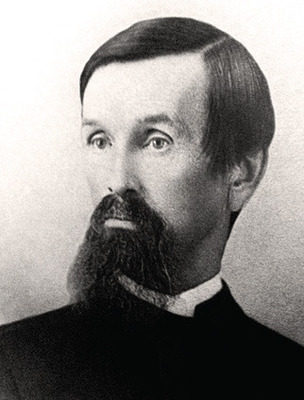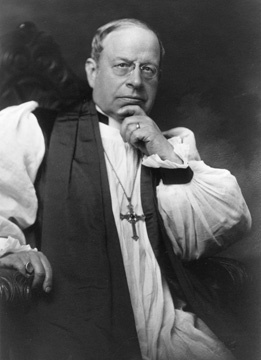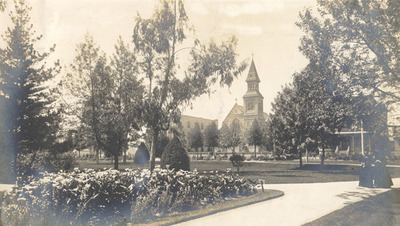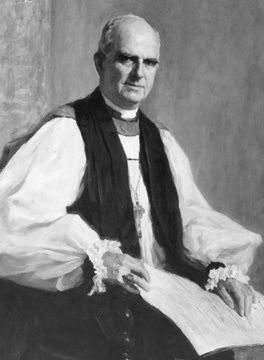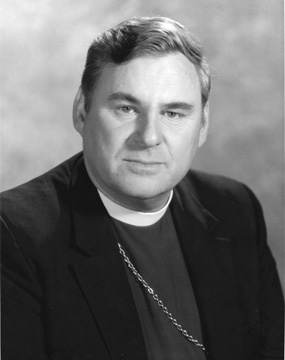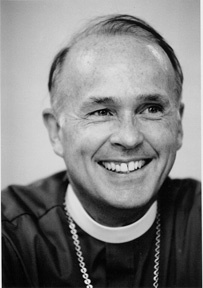One hundred-fifty years ago, in 1864, Christmas Day fell on a Sunday. The Civil War continued to divide and to grieve the nation. Poet Henry Wadsworth Longfellow, who decried his son’s decision to join the Union forces, had penned these familiar words: “And in despair I bowed my head; ‘There is no peace on earth,’ I said; For hate is strong and mocks the song of peace on earth, good will to men.”

St. Athanasius Church, pictured in 1865, first home of the oldest continuing Protestant congregation in Los Angeles. It was located at Temple and New High streets, just across Spring Street from where the City Hall was built some years later.
In Los Angeles, where Unionist General Phineas Banning and Southern Democrat Benjamin Wilson — both Episcopalians — had given land to build the U.S. Drum Barracks to mitigate any local insurgency, a new missionary priest, Elias Birdsall, then age 34, had arrived from Evansville, Indiana, deployed by Bishop William Ingraham Kip of San Francisco. That Christmas morning, Mr. Birdsall read Morning Prayer with some 10 people gathered in the Odd Fellows Hall, located near the Old Plaza. A few weeks before, the Great Drought of 1862-65 had begun to ease.
Some 83 years earlier, in 1781, the first settlers, “los pobladores,” had founded El Pueblo de Nuestra Senora la Reina de Los Angeles de Porciuncula, the city of Our Lady, Queen of Angels of the River Porciuncula. The name recalls the basilica that continues to shelter St. Francis’ Little Portion chapel in the famed Umbrian town of Assisi, where the Italian countryside and Mediterranean climate are much like those of rural Southern California.
By 1864, wine-making was a principal industry of Los Angeles. Benjamin Wilson’s Lake Vineyard Estate, which spanned 1,300 acres of present-day San Marino, that year produced an impressive 140,000 gallons. A search for timber suitable for cask-making sent Don Benito on the first recorded expedition to the peak now known as Mount Wilson, home of the observatory where Edwin Hubble first viewed galaxies beyond the Milky Way. When Bishop Kip first visited Southern California, he marveled at the lush vines and groves of Wilson’s estate, where he returned as a guest several times.
In 1851-52, Benjamin Wilson served as the second mayor of Los Angeles after California statehood. He was a charter member of the County Board of Supervisors, and a state senator for two terms. A mountain man and fur trapper who had been orphaned in Tennessee, Wilson crossed the country seeking passage to China. Instead he married into California’s prominent Yorba family, and he came to own ranch lands that at various times stretched from Riverside to Beverly Hills.
First continuing Protestant church in Los Angeles
Wilson’s abiding Christian faith — and his desire for English-language church services to help tame the wild and dangerous frontier town that was Los Angeles at the time — prompted him to partner with Presbyterians, Methodists and Episcopalians to establish a continuing Protestant congregation in the city. Various ministers came and went, but it was Birdsall’s Episcopal congregation of St. Athanasius — named for the 4th-century bishop of Alexandria — that eventually took hold. In 1865, the congregation occupied its first, red-brick building at Temple and New High streets, where the present L.A. City Hall was later built just across Spring Street. (The Cathedral Center church’s present brick-red exterior echoes the color of that first house of worship.)
Mr. Birdsall put the parish on the map the next April 19 when he delivered the public funeral oration following the assassination of President Abraham Lincoln. The sermon text survives, and it will be re-read April 19, 2015 in a commemorative observance. The sermon’s original call for mutual respect and understanding still rings true in today’s politically fragmented contexts.
Mr. Birdsall also gained public awareness for the congregation through a lecture series offered the same year on topics of local and international significance, including political issues in Latin America. Recently renamed the “Birdsall Lectures,” the series will be renewed this coming year to address three similarly timely topics: Middle East peace, church history, and climate change, the latter forum to be webcast March 24 from Campbell Hall school, North Hollywood, in a program featuring Presiding Bishop Katharine Jefferts Schori.
Growing in ministry: a new diocese
Fast forward now through major events in the life of the congregation — starting in 1872 when Bishop Kip deeded to the parish 35 acres of downtown real estate. Known as the 35-acre Lot, the tract was bordered on the north by present-day Sixth Street and on the south by Seventh Street, reaching from Figueroa Street west to Lucas Street, on which Good Samaritan Hospital is also located. To honor the bishop, nearby streets were named Kip, Ingraham and William, now Bixel. The year 1872 came early in the economic downturn known as the “Long Depression,” and lots were gradually divided out and sold — sometimes for as little as $75 each — to sustain St. Athanasius Church. Vestry members at the time included Judge H.K.S. O’Melveny, whose son founded the venerable law firm, and William “Billy” Pridham of Wells Fargo & Company, among others.
On Christmas Day 1883 the parish moved from the small brick church to its newly built Victorian gothic sanctuary at 523 S. Olive Street, across from Central Park. At this time, the parish’s name was changed to St. Paul’s, and the church was where delegates gathered 12 years later, in 1895, to organize the Diocese of Los Angeles. There they greeted the first bishop of Los Angeles, Joseph Horsfall Johnson, previously rector of Christ Church, Detroit, who in 1899 designated St. Paul’s as the diocese’s first pro-cathedral. In 1896, Bishop Johnson also assisted members of the original St. Athanasius’ Parish to reclaim that congregation’s name to form a new mission to serve the nearby Temple-Beaudry area. These congregants preferred a small-church setting, and built a new sanctuary on Custer Street. When the gift of land across from Echo Park Lake became available in 1918, the wooden church was cut in half and transported by truck to this location — a move that prompted the Los Angeles Times to quip that this was the first time many Angelenos had seen the inside of a church. During these years, from 1916 to 1926, St. Athanasius was served by one of its most notable and beloved rectors, the Rev. Thomas C. Marshall, who went on to direct Good Samaritan Hospital.
St. Paul’s Cathedral
Earlier, from 1901 to 1908, St. Paul’s Pro-cathedral was served by Dean J.J. Wilkins, who went on to become secretary of a $5 million national fund for clergy pensions. Installed thereafter in 1911 was the pro-cathedral’s historic Murray Harris pipe organ, the ranks of which are heard today in St. James’ Church on Wilshire Boulevard.
During this period, Hollywood was emerging with the first locally produced feature movies, and President Woodrow Wilson visited the pro-cathedral in 1919 just weeks before suffering the stroke that left him greatly incapacitated. Dean William McCormack’s sermon that Sunday was titled “God’s Formula for Despondency.” After World War I, Central Park was renamed Pershing Square, and in 1920 the pro-cathedral was the site of the ordination to the episcopate of Bishop Coadjutor William Bertrand Stevens, who had previously served parishes in San Antonio and the Bronx, New York. In 1922, the pro-cathedral site was sold to make way for the present Biltmore Hotel. It was time to build a larger church to serve the growing city of 1.2 million residents, which had grown from some 102,000 in 1900.
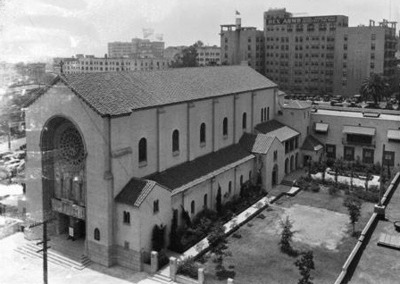
St. Paul’s Cathedral, located on Figueroa Street at Fifth Street, Los Angeles, was completed in 1924 and demolished in 1980 after earthquake damage made the building dangerously unstable.
St. Paul’s Cathedral was consecrated in 1924 having been designed by architects Johnson, Kaufman & Coate, led by Reginald Johnson, son of Bishop Johnson. Other landmarks of this era designed by Reginald Johnson include All Saints Church in Pasadena, the Santa Barbara Biltmore Hotel, and Good Samaritan Hospital, with its All Souls’ Chapel as a scale model of the new cathedral church. At this time, St. John’s Parish in Los Angeles also built its new Italianate church that would in 2008 be named the diocese’s pro-cathedral.
After serving the diocese for 32 years, Bishop Johnson died in 1928, and the cathedral was packed with an overflow congregation mourning the loss of their bishop who was highly esteemed for his great love of people and his entrepreneurial skill. Also much loved by the people, Bishop Stevens took the helm as diocesan, the year before the stock market crashed and sent the nation and the world spiraling into the Great Depression. Bishop Stevens did all he could to provide for the people and congregations of the diocese, cutting his own pay significantly and raising morale through a marathon pilgrimage to visit all congregations in the span of several days.
World War II and the postwar boom
In 1937 the cathedral called as its new dean Francis Eric Bloy, who was later elected third bishop of Los Angeles following Bishop Stevens’ untimely death in 1947 at age 60 after complications of surgery. For Bishop Stevens’ funeral, St. Paul’s Cathedral again was packed with mourners.
Both St. Paul’s Cathedral and St. Athanasius Church in Echo Park provided strong pastoral support to families and the community throughout the Second World War. The internment of Japanese-Americans, many of them members of nearby St. Mary’s Church, Mariposa Avenue, was a particularly important area of outreach for Bishop Stevens and other members of the diocese. Later, as the nation moved forward, the post-war building boom created challenges for the diocese in keeping pace with population growth. During Bishop Bloy’s tenure, 46 of the 140 existing parishes and missions of the Diocese of Los Angeles were founded. Bishop Bloy took an active role in the fund drives and appeared in a filmstrip, “The Bishop and the Genie,” in which he travelled the diocese accompanied by a cartoon genie — created by Bill Hanna of Hanna-Barbera, voice by Stan Freberg — to show the need for increased mission. In the years 1948-52, Dean John M. Krumm served St. Paul’s Cathedral, moving on to become chaplain at Columbia University and later bishop of Southern Ohio.
The Cathedral Congregation celebrated its 100th anniversary in 1965 with October services hosting the Episcopal Church’s Presiding Bishop John Elbridge Hines, and Lord Bishop of London Robert Wright Stopford. Two months earlier, the Watts Riots had painfully underscored the imperative for increased civil rights progress in Los Angeles together with the nation. President Lyndon Johnson had the year before declared the War on Poverty, and Presiding Bishop Hines followed in 1967-1969 with the General Convention Special Program to address the related effects of racism and poverty, among other social ills.
Earth-shaking change, new ministry
Meanwhile, suburban growth resulted in more people attending church services locally, and fewer people residing downtown, or coming in for shopping, movies and other activities. Thus the once-large cathedral congregation declined in membership, and additional challenges were posed when the 1971 Sylmar earthquake, a 6.6-temblor, damaged the cathedral buildings.
In 1974, the enthronement of Bishop Robert Claflin Rusack occurred in the cathedral following his election as fourth bishop of Los Angeles, and after division of the diocese to create the new Diocese of San Diego. A decade earlier, Bishop Rusack was ordained to the episcopate after his election in 1964 as bishop suffragan of Los Angeles. The role and history of the cathedral was important to him, and working with deans including Everett Simson he made various efforts to draw people to the cathedral. One proposal to build a “Cathedral in the Sky,” with a sanctuary affording panoramic views atop an income-generating office tower, was dismissed as unviable. Meanwhile, even as 50 years of wear and deferred maintenance continued to take their toll, the cathedral remained a venue for various large services, including the January 1977 ordination of new priests including Victoria Hatch, the first woman so elevated in Los Angeles. Also ordained that day was Gary Hall, current dean of Washington National Cathedral.
By 1979, the Cathedral Corporation had reached the point of recommending the sale of the cathedral property and demolition of the church rather than meet the high cost of repair and renovation. Diocesan Convention voted for this action over Bishop Rusack’s objection, and the property was sold to developers for the Mitsui Fudoson Tower, now known as Figueroa at Wilshire.
A continuing cathedral ministry
Bishop Rusack engaged the Cathedral Congregation’s warden, Randolph Kimmler, to arrange for services to continue in the Good Samaritan Hospital chapel, and for the preservation and storage of various artifacts, including the cathedra, crafted with wood from Winchester Cathedral, and carvings by artisans also active with the Oberammergau Passion Play. Also retained were the historic font, altar, and pulpit, the latter a gift in memory of Arthur Letts, founder of the Broadway department stores.
Meanwhile, the corpus of the sale proceeds were invested to fund an innovative grants program, and the “Cathedral Without Walls” initiative partnered with local congregations for creative observances, including the Archbishop of Canterbury’s 1981 visit to Epiphany Church in East Los Angeles, where Cesar Chavez was a frequent visitor in his advocacy for farm workers and Latino civil rights. Archbishop Robert Runcie soon returned to Los Angeles to attend the 1985 General Convention in Anaheim, where Presiding Bishop Edmond Lee Browning was elected to office.
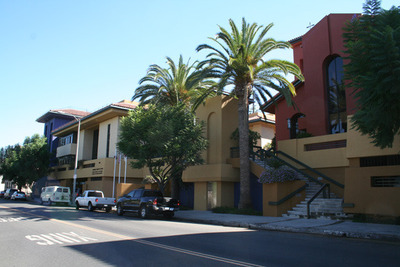
The Cathedral Center of St. Paul, located on Echo Park Avenue in Los Angeles, was opened in 1994. It is the administrative and ministry hub of the Episcopal Diocese of Los Angeles
The Cathedral Center of St. Paul
Although Bishop Rusack had been in conversation with various Los Angeles city churches about the possibility of pro-cathedral ministry, his death in 1986 at age 60 meant that these considerations fell to his successor, Frederick Houk Borsch, elected fifth bishop of Los Angeles in 1988. By this time, the Cathedral Congregation’s rector, Jon Bruno, had succeeded in reuniting the parish as the Church of St. Athanasius and St. Paul. He also suggested the concept of building the present Cathedral Center, an idea that literally came to him one night in a dream. Ground was broken in 1992 on the $14-million facility built to house — in addition to the central church, with services in English, Korean, and Spanish — diocesan offices, a retreat center, bookstore, credit union, and space for programs serving youth at risk, including gang diversion. Construction was overseen by Kristi Wallace, executive director of the Cathedral Center.
When the Cathedral Center was consecrated in 1994, the Los Angeles Times, in an editorial titled “The Flock That Wouldn’t Stray,” praised the congregation’s dedicated ministry in the community.
In 1999, Joseph Jon Bruno was elected bishop coadjutor of the diocese, and his seating as sixth bishop of Los Angeles took place outdoors in a celebration during which the congregation dispersed around Echo Park Lake to join hands in solidarity for shared ministry and particular efforts to reduce violence in all forms. During this time, the Cathedral Center and diocesan community also expanded advocacy for full inclusion in church and society of persons of all sexual orientations, also acting strategically for same-gender marriage equality. Spanning some 40 years, these efforts reached milestones in 2004 when Bishop Bruno presided in the Cathedral Center church to bless the union of longtime priest Malcolm Boyd and his partner, Mark Thompson, and again in 2014 when Bishop Bruno performed the church-and-civil wedding of the congregation’s current priest-in-charge, the Rev. Frank Alton, and his husband, Saul Renteria.
As the Congregation of St. Athanasius prepares to gather this Christmas Day at the Cathedral Center of St. Paul, prayers of thanksgiving are offered for the faithfulness of generations past, present and future, each engaging God’s gifts in this place across horizons and heritage.
— Robert Williams is canon historiographer of the Diocese of Los Angeles. His new book, Horizons and Heritage: The Episcopal Church Marks 150 Years in Southern California, is scheduled for publication in 2015.


